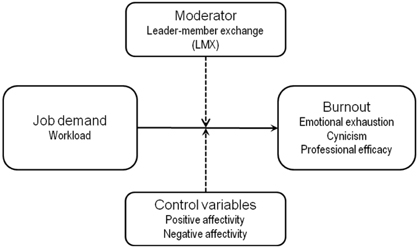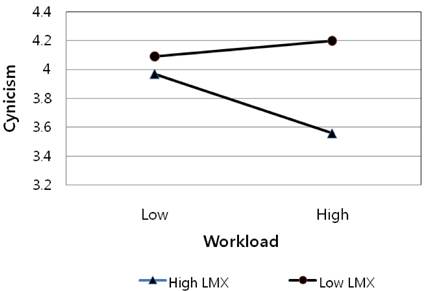Nutr Res Pract.
2011 Feb;5(1):80-87.
Moderating effects of leader-member exchange (LMX) on job burnout in dietitians and chefs of institutional foodservice
- Affiliations
-
- 1Department of Food and Nutrition, Seoul Women's University, 623 Hwarangro, Nowon-gu, Seoul 139-774, Korea. klee@swu.ac.kr
Abstract
- The objectives of the study were to investigate job burnout and leader-member exchange (LMX) levels as well as to evaluate buffering effects of LMX on burnout among dietitians and chefs at institutional foodservices. Hypotheses were proposed based on the Job Demands-Resources model and LMX theory. The study population consisted of dietitians and chefs who were in charge of managing unit operations in a nationwide contract management company. Positive/negative affectivity, workload, job burnout, and LMX scales that had been validated in previous research were adopted. A total of 552 questionnaires were distributed and 154 responses were returned. Results indicated that respondents' burnout levels were moderate and emotional exhaustion was greater than cynicism. In terms of LMX, the surveyed dietitians and chefs showed higher respect toward their supervisors than loyalty. When positive affectivity and negative affectivity were controlled, workload influenced emotional exhaustion and professional efficacy significantly. With affectivity and workload controlled, however, LMX did not influence any dimensions of burnout. The moderating effect of LMX on the relationship between workload and cynicism was significant. That is, the effect of workload on cynicism was weak if the dietitians and chefs perceived the relationship with their supervisor positively. Based on the findings and literature reviewed, how to mitigate job burnout among foodservice managers is discussed.
Keyword
Figure
Reference
-
1. McShane SL, Von Glinow MA. Organizational Behavior. 2000. Seoul: Irwin McGraw-Hill;134–150.2. Lazarus RS. From psychological stress to the emotions: a history of changing outlooks. Annu Rev Psychol. 1993. 44:1–21.
Article3. Maslach C, Jackson SE. The measurement of experienced burnout. J Organ Behav. 1981. 2:99–113.
Article4. Maslach C, Schaufeli WB, Leiter MP. Job burnout. Annu Rev Psychol. 2001. 52:397–422.
Article5. Lee KE, Shin KH. Job burnout, engagement and turnover intention of dietitians and chefs at a contract foodservice management company. J Community Nutr. 2005. 7:100–106.6. Buick I, Thomas M. Why do middle managers in hotels burn out? Int J Contemporary Hospitality Manage. 2001. 13:304–309.
Article7. Lee J, Kim Y. A study on the relations of job stress and turnover intention about the employee of F&B. J Tourism Manage Res. 2002. 6:217–241.8. Kang B, Twigg NW, Hertzman J. An examination of social support and social identity factors and their relationship to certified chefs' burnout. Int J Hospitality Manage. 2010. 29:168–176.
Article9. Ghiselli RF, La Lopa JM, Bai B. Job satisfaction, life satisfaction, and turnover intent. Cornell HRA Quart. 2001. 42:28–37.
Article10. Vallen G. Organizational climate and burnout. Cornell HRA Quart. 1993. 34:54–59.
Article11. Ingram A, Brown S. Labor turnover in four and five crown Edinburg hotels: managers' perceptions and strategies to cope. Praxis. 2000. 2:80–99.12. Kwak TK, Ryu ES, Lee HS, Ryu K, Choi SK, Hong WS, Jang MR, Shin ES, Moon HK, Jang HJ, Park SJ, Choi EH, Lee KE. Institutional Foodservice Operations. 2008. Seoul: Shin Kwang Publishing Co.;14–15.13. Bakker AB, Demerouti E, Euwema MC. Job resources buffer the impact of job demands on burnout. J Occup Health Psychol. 2005. 10:170–180.
Article14. Thomas CH, Lankau MJ. Preventing burnout: the effects of LMX and mentoring on socialization, role stress, and burnout. Hum Resour Manage. 2009. 48:417–432.
Article15. Schaufeli WB, Bakker AB. Job demands, job resources and their relationship with burnout and engagement: a multi-sample study. J Organ Behav. 2004. 25:293–315.
Article16. Bakker AB, Demerouti E, Verbeke W. Using the job demands-resources model to predict burnout and performance. Hum Resour Manage. 2004. 43:83–104.
Article17. Humborstad SI, Humborstad B, Whitfield R. Burnout and service employees' willingness to deliver quality service. J Hum Resour Hosp Tour. 2008. 7:45–64.
Article18. Tabacchi M, Krone C, Farber B. A support system to mitigate manager burnout. Cornell HRA Quart. 1990. 31:32–37.
Article19. Graen GB, Uhl-Bien M. Relationship-based approach to leadership: Development of leader-member exchange(LMX) theory of leadership over 25 years: applying a multi-level multi-domain perspective. The Leadership Quarterly. 1995. 6:219–247.
Article20. Lee HH, Kim EJ, Lee MK. A validation study of Korea positive and negative affect schedule: The PANAS scales. Korean J Clin Psychol. 2003. 22:935–946.21. Spector PE, Jex SM. Development of four self-report measures of job stressors and strain: Interpersonal conflict at work scale, organizational constraints scale, quantitative workload inventory, and physical symptoms inventory. J Occup Health Psychol. 1998. 3:356–367.
Article22. Maslach C, Jackson SE, Leiter MP. Maslach Burnout Inventory Manual. 1996. 3rd ed. Palo Alto, CA: Consulting Psychologists Press;10.23. Liden RC, Maslyn JM. Multidimensionality of leader-member exchange: an empirical assessment through scale development. J Manage. 1998. 24:43–72.
Article24. Krone C, Tabacchi M, Farber B. Managers. Cornell HRA Quart. 1989. 30:58–63.25. Krone C, Tabacchi M, Farber B. A conceptual and empirical investigation of workplace burnout in foodservice management. Hospitality Edu Res J. 1989. 13:83–91.
Article26. Reynolds D. Mitigating burnout in foodservice management. Nations Restaurant News. 1995. 29:32–34.27. Kim HJ, Shin KH, Umbreit WT. Hotel job burnout: the role of personality characteristics. Int J Hospitality Manage. 2007. 26:421–434.
Article28. Song NC, Lee HS, Lee KE. The factors (job burnout, job engagement, the workplace safety) influencing employees' job satisfaction in school food service operations. Korean J Community Nutr. 2007. 12:606–616.29. Demerouti E, Bakker AB, Nachreiner F, Schaufeli WB. The job demands-resources model of burnout. J Appl Psychol. 2001. 86:499–512.
Article30. Demir A, Ulusoy M, Ulusoy MF. Investigation of factors influencing burnout levels in the professional and private lives of nurses. Int J Nurs Stud. 2003. 40:807–827.
Article31. Borchgrevink CP, Boster FJ. Leader-member exchange development: a hospitality antecedent investigation. Int J Hospitality Manag. 1997. 16:241–259.
Article32. Iverson RD, Olekalns M, Erwin PJ. Affectivity, organizational stressors, and absenteeism: A causal model of burnout and its consequences. J Vocat Behav. 1998. 52:1–23.
Article33. Ettner SL, Grzywacz JG. Workers' perceptions of how jobs affect health: a social ecological perspective. J Occup Health Psychol. 2001. 6:101–113.
Article34. Hoge T, Bussing A. The impact of sense of coherence and negative affectivity on the work stressor-strain relationship. J Occup Health Psychol. 2004. 9:195–205.
Article35. Yun HJ, Lee JE, Hong WS. A study on factors of job satisfaction and burnout of hospital dietitians. Korean J Community Nutr. 2009. 14:100–113.36. Lee HS. Factors influencing on the job satisfaction and the turnover intention of dietitians working in the institutions for the disabled in Korea-Focused on the general characteristics and the job burnout. Korean J Community Nutr. 2009. 14:182–189.37. Fall ML, Wolf KN, Schiller MR, Wilson SL. Dietetic technicians report low to moderate levels of burnout. J Am Diet Assoc. 2003. 103:1520–1522.
Article38. Jackson EJ, Turner JA, Brief AP. Correlations of burnout among public service lawyers. J Organ Behav. 1987. 8:338–349.39. Lee RT, Ashforth BE. A meta-analytic examination of the correlates of the three dimensions of job burnout. J Appl Psychol. 1996. 81:123–133.
Article40. Maslach C, Jackson SE. Burnout in organizational settings. Appl Soc Psychol Annu. 1984. 5:133–153.41. Occupational Outlook Handbook 2010-2011 Edition. Bureau of Labor Statistics [Internet]. cited 2010 November 22. Available from: http://www.bls.gov/oco.42. Fine GA. The culture of production: aesthetic choices and constraints in perceptions and union participation. Am J Sociol. 1992. 97:1268–1294.43. Gerstner CR, Day DV. A meta-analysis review of leader-member exchange theory: Correlates and construct issues. J Appl Psychol. 1997. 82:827–844.
Article44. Seltzer J, Numerof R. Supervisory leadership and subordinate burnout. Acad Manage J. 1998. 31:439–446.
Article45. Byrne ZS, Hochwarter WA. Perceived organizational support and performance. J Manage Psychol. 2008. 23:54–72.
Article46. Bakker AB, Demerouti E, Taris T, Schaufeli WB, Schreurs P. A multi-group analysis of the job demands-resources model in four home care organizations. Int J Stress Manag. 2003. 10:16–38.
Article47. Van Dierendonck D, Schaufeli WB, Buunk BP. Toward a process model of burnout: results from a secondary analysis. European J Work Organizat Psychol. 2001. 10:41–52.
Article48. Kim WH, Shin KH, Heo CG, Lee JH. Emotional labor and burnout: the moderating effect of autonomy and social support. Korean J Health Psychol. 2007. 12:905–921.49. Mortensen JK, Nyland NK, Fullmer S, Eggett DL. Professional involvement is associated with increased job satisfaction among dietitians. J Am Diet Assoc. 2002. 102:1452–1454.
Article
- Full Text Links
- Actions
-
Cited
- CITED
-
- Close
- Share
- Similar articles
-
- Effects of Leader-Member Exchange of Nurses who Return to Work after Parental Leave on Conflict between Work and Family: Focus on the Mediating Effects of Job Stress
- Influence of Leader-Member Exchange Quality of Head Nurses and Clinical Nurses on Organizational Commitment and Job Satisfaction in Clinical Nurses
- The Effect of Nurses’ Perceived Leader-Member Exchange on Psychological Ownership, Job Engagement, and Turnover Intention
- The Moderating Role of LeadereMember Exchange in the Relationships Between Emotional Labor and Burnout in Clinical Nurses
- A Study on the Influence of Dietitians' Service Leadership on School Foodservice Employees' Attitudes



